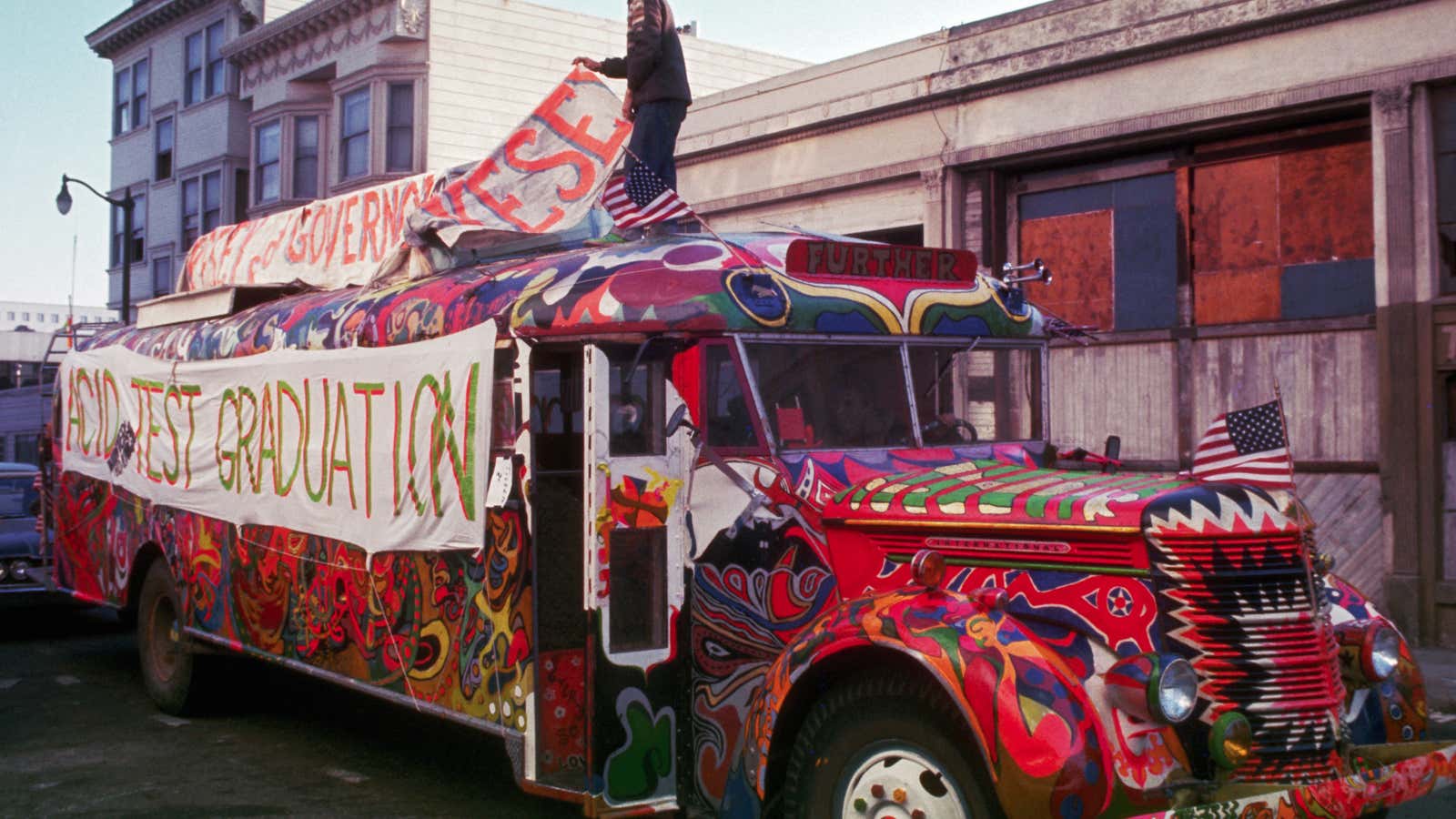It had been a good 15 years since I read The Electric Kool-Aid Acid Test, but when I learned of Tom Wolfe’s death on Tuesday morning, I pulled my old copy off the shelf.
The seminal 1968 chronicle of the counterculture is Wolfe’s account of living and traveling with the writer Ken Kesey and his Merry Pranksters, in a day-glo bus equipped with loads of LSD. In today’s Los Angeles, 50 years after the book was published, that metaphorical bus is still rolling, but it looks very different: corporate-sponsored music festivals, luxury cannabis dispensaries, micro-dosing as a productivity hack, Goop-endorsed crystal healing, and the artfully staged Instagrams of #vanlife.
Wolfe made the case that the Acid Tests—LSD-laden parties with trip-enhancing experimental live music by the Grateful Dead, art nouveau visuals, black lights, and multi-color projections—laid the foundation for psychedelic style. And he anticipated, correctly, that the Merry Pranksters legacy would be idealized and imitated far beyond that moment:
Later other impresarios and performers would recreate the Prankster styles with a sophistication the Pranksters never dreamed of. Art is not eternal, boys. The posters became works of art in the accepted cultural tradition. Others would even play the Dead’s sound more successfully, commercially, anyway, than the Dead. Others would do the mixed-media thing until it was pure ambrosial candy for the brain with creamy filling every time. To which Kesey would say: “They know where it is, but they don’t know what it is.”
It’s easy to feel nostalgic for the simpler world of the counter-culture 1960s. And in the midst of a new “new age”—think Burning Man, post-work sound baths, and weekend ayahuasca retreats—our perception of its cultural precedents is often scrubbed clean, romanticized, and repackaged.
But diving back into Wolfe’s intricately constructed account is a reminder that it was all a lot more complicated than that—his stark documentation putting you right there, in the place and time. And that shit was messy. Yes, the Hell’s Angels happily convened with the Merry Pranksters at Kesey’s commune in northern California, but a beer-soaked, supposedly consensual gangbang also ensued, which Wolfe describes in lurid non-judgmental detail, before adding, simply, “and we have gone with the flow.” Complicated, messy moments such as these—wives and kids on the sidelines, bad trips, Kesey bombing onstage and deflating the crowd at an anti-war rally—pepper the book.
So do Easter eggs of prescient details, connecting today’s Bay Area-centered cyber-culture to the counterculture that preceded it. In the first few pages of The Electric Kool-Aid Acid Test, Stewart Brand appears shirtless behind the wheel of a pickup, bumping through the streets of San Francisco— “just an Indian bead necktie on bare skin and a white butcher’s coat with medals from the King of Sweden on it.” Later in the book, Brand, described at age 27 as “an ex-biologist who had run across the Indian peyote cults in Arizona and New Mexico” becomes obsessed, on LSD, with the idea that humans had never seen a photograph of the whole earth.
We now know that Brand would successfully lobby for NASA to take such a photo, which then covered his Whole Earth Catalog—a sourcebook and bible for hippie survivalists. Decades later, Brand would take the same individualist values that informed the Whole Earth and apply them to the development of the worldwide web, of which he was an early architect.
Michael Pollan—the celebrated food advocate and, lately, “reluctant psychonaut”—recently told Terry Gross how psychedelic mushrooms dissolved his sense of self and freed him from his ego. Five decades earlier, Wolfe described the same phenomenon on LSD, discussing man as “an atom in a molecule in a fingernail of a giant being”:
A few brilliant men grasp the structure of the entire fingernail. A few geniuses, like Einstein, may even see that they’re all part of a finger of some sort … All the while, however, many men get an occasional glimpse of another fingernail from another finger flashing by or even a whole finger or even the surface of the giant being’s face and they realize instinctively that this is a part of a pattern they’re all involved in, although they are totally powerfulness to explain it by cause and effect. And then–some visionary, through some accident…through some quirk of metabolism, through some drug perhaps, has his doors of perception opened for an instant and he almost sees—Presque vu! —the entire being and he knows for the first time that there is a whole … other pattern here.
When I first read The Electric Kool-Aid Acid Test as a kid, I too was struck by a whole other pattern—connections I had not previously perceived between the artists, writers, and musicians I loved. Jack Kerouac and the Grateful Dead, Neal Cassady and Hunter S. Thompson, Kesey and Wolfe himself. Reopening the book, I still feel the pull of those cultural currents, half a century later.
Of course, I now know that what Wolfe made appear so effortless in the Acid Test is no small feat. It may read like a monologue about an insane road trip with a head full of drugs, but it is also based on letters, recordings, interviews, photos, diaries, video footage, and conversations with dozens of sources. It’s a masterpiece of journalism, and I’m profoundly grateful to him for taking me on that trip.
